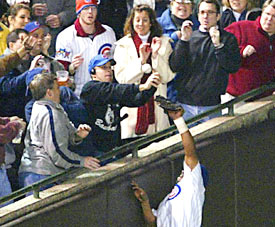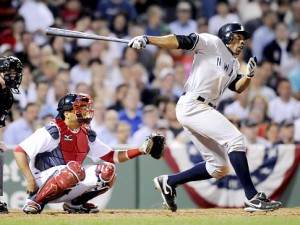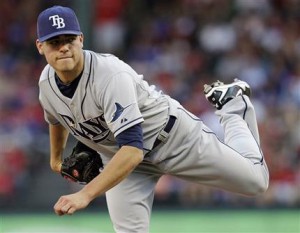The Nats season may be over, and the Redskins may be 3-1 (thus implying that 98% of local sports radio be devoted to the minutae of the team), but i’m hoping Tom Boswell takes some baseball questions still during his normal monday morning chat.
Questions are edited for clarity and space, and I write my answer before reading Boswell’s. We’ll only address baseball-related questions.
Q: Was the last day of the 2011 baseball season the greatest day in baseball history?
A: Well, considering that baseball’s been played for 150+ years, and we’ve only lived to see and judge 25-30 years of it, and we’ve only had baseball readily available on TV to the extent where we could truly appreciate a night like what happened … its tough to say its the best ever. Yes absolutely though it was the best in recent memory. Boswell agrees.
Q: Thoughts on the Red Sox’s parting ways with Franconia and possibly Epstein?
A: The Red Sox spent an awful lot of money … and ended up with an awful lot of injuries to those well-paid players, especially in the rotation. In September they were basically without 3/5ths at one point of the opening day roster. No team can survive that, especially one that has traded so many of its prospects lately to acquire the hitting talent it has. Terry Franconia has been there a while and, while its probably not his fault the team plummeted as it did, he’ll take the fall. Theo Epstein: I’d think he’d want to stay and try to get one more WS win out of this team. Unfortunately it probably isn’t happening any time soon: his team still has a bunch of under-performers under contract for 2012 and looks to be stuck with a bloated payroll without many impact players, again. Boswell thinks Franconia got the short end of the stick, and that any firing of Epstein would be a major over-reaction. Agreed.
Q: Did the Orioles “over-celebrate” by beating the Red Sox on the last day?
A: Maybe so. But its hard to fault the team for playing and winning a playoff-caliber game. Boswell didn’t answer this part, but did talk about Matt Moore and how good he’s looked. Moore was the subject of an analysis post I did over the weekend. He looked fantastic and could be a secret weapon for Tampa Bay this playoffs.
Q: Will the Red Sox find someone to manage their club as good as Franconia?
A: Probably not; there’s a ton of good candidates out there but in all likelihood we won’t see a major discipline guy taking over. Odds are that we’ll see a bench coach or someone within the organization. Boswell says if Valentine goes, expect even more drama.
Q: (Great Question): should a team’s success factor into the Cy Young and MVP voting?
A: Cy Young: no. It shouldn’t matter how the team does. If a guy is the best pitcher in the league, he’s the best pitcher. Yes “Wins” are a flawed statistic, giving credit to a pitcher for only half the battle in winning a ball game. But mostly pitching is an individual, mano-y-mano embarkment. MVP? Yes I believe the team’s position in the standings has an effect. Simple question; how can you be the Most Valuable Player in the league for a team that is 20 games under .500? I just don’t think you can be. If you’re not leading a team to the playoffs, or playing meaningful games 100% of the time, then it doesn’t matter how valuable you are to your own team, let alone the rest of the league. Boswell posits an argument i’ve never heard; batters get 650-700 plate appearances but starting pitchers face > 1000 batters. Good argument; still not enough to get me to consider pitchers for MVP awards.
Q: How did a supposedly great analysis team like the Red Sox err so badly in the Carl Crawford contract?
A: Carl Crawford was a nice player in Tampa, but it was always going to be a risk putting someone who wasn’t used to the pressure cooker of baseball in Boston or New York who wasn’t used to it. The Red Sox vastly overpaid for Crawford, feeling as if they had to pay him more than the Jayson Werth contract, and they ended up with a lesser player. Boswell points out some interesting observations; Crawford’s power is to right, he never pulls the ball and his asset in defense is speed. All three of those points are completely negated by playing in Fenway. Could get ugly in Boston.
Q: When are the Nats going to re-sign Ryan Zimmerman?
A: I’d guess after NEXT season. Despite the supposed pressure to get him re-upped on a big contract, he already IS on a big contract. And that contract runs through 2013. So he’s still got two years on it, so no point in talking about it or worrying about it. Boswell says the team should push this, but guesses Zimmerman waits until he has a good start to 2012 to negotiate from strength, not from the weakness following a sub-par year as he had in 2011.
Q: Did Davey Johnson have a bad road split? Is he going to be the 2012 manager?
A: Just did some quick analysis: the team had 38 road games after Johnson took over and went 18-20 in them. That’s actually better than their overall 36-45 record on the road all season. I don’t know why there’s stories about a manager search; why wouldn’t he come back to manage in 2012? Boswell notes he went 40-40 after the initial 3-game series loss to the Angels.
Q: Thoughts on Jose Reyes’ sitting down to protect his average?
A: Bush league. Ted Williams, he is not. If your manager takes you out to give the home crowd a chance to give you one last cheer, that’s acceptable. To ask out of a game after bunting for a hit is akin to an NBA player purposely missing a shot to get an extra rebound so as to get a triple-double. Boswell agrees.
Q: Do the Nats need to get a high priced FA starting pitcher?
A: Well. Lets answer the question this way. Yes, they need another FA pitcher, but there’s not one available this year that will be worth the money. This season’s crop of FA starters is weak and the two big money teams both desperately need starting pitching and will be driving prices WAY up on guys like CJ Wilson and Edwin Jackson, far over what they’re worth. I think the team needs to stay out of these feeding frenzies. 2013’s crop is far better, and we also have enough pitching depth to possibly work a trade. Boswell says its a tough call then reminds everyone we went after Greinke hard and couldn’t believe the deal was turned down.
Q: What do the Nats do with the leadoff position for 2012?
A: Amazingly, they go into this off-season with pretty much the same issue they had LAST off season. They need a reliable lead-off hitter, and they need a reliable center fielder. They’d love to get one guy who can do both jobs. Personally, I think a trade is happening this off season, with the team going after BJ Upton again, pitching Tampa Bay to save the $6-$7M they’re going to have to pay him in his last arbitration year. There’s a couple of FA center fielders of note, but they’re under performers or injury risks (David DeJesus, Grady Sizemore being the two names i’d think about). Might as well roll the dice with one more year of Rick Ankiel. Boswell notes that Goodwin and Rendon could be hitting 1-2 in a couple years. Not exactly the question that was asked.
Q: Have the Nats considered moving Desmond to CF, and sliding Espinosa to SS and playing Lombardozzi at 2B?
A: Hmmmm. I havn’t seen this particular formation postulated. I’d say this is a no-go because Lombardozzi looked 110% overmatched in his September call-up and may have a ceiling of utility guy. But its an interesting question. What about Lombardozzi in center? The question is; can he hit leadoff? Boswell doesn’t think Desmond can ever be a good enough leadoff hitter.
Q: Do the Nats make a run at Terry Franconia?
A: No way. Johnson is just as good a manager. You stick with what you have. Boswell agrees.
Q: Is CJ Wilson worth giving up our first round pick in free agency? What about Pujols or Fielder?
A: Yes …. but he’s not going to be worth the sky-high salary that he’ll be offered by the Yankees to come in and help restore their pitching staff. Both Pujols/Fielder would be great in the short term but would likely be albatross contracts before they’re said and done (as A-Rod’s already looks, and as Ryan Howards looks like it will be). Boswell says he likes our current arms more than Wilson, and says Morse at $4M is better value than Pujols at $25M. True.
Q: What do you make of the way the Nats finished the season?
A: Very promising … with some caution. Beware September success, since your young guys often times are playing other team’s younger guys. The only meaningful games we really played in September were against teams in playoff races (Atlanta). I will say that the big take away from this finish was just how poorly the team fared by giving starts to Livan Hernandez and Jason Marquis. Once those guys were removed from the rotation and replaced with our upper end prospects, the team won and won frequently. Boswell agrees, pointing out that this team got to 80 wins, only one of which was by Strasburg!
Q: Were the 80 wins ahead of your expectations?
A: Absolutely. I can’t find any proof of this, but I think 72-75 wins was considered a great goal for 2011. 80 wins, a 10 game improvement over 2010 (itself a 10 game improvement over 2009) is a huge win for this team. Another 10-game improvement suddenly puts this team squarely into Wild Card competition, and another 10-game improvement in 2013 puts us as World Series contenders. I think this is a great path and a great goal. Boswell predicted 72 at start, bumped to 77 mid-season.
Q: What does the Nats focus on in the offseason? SP or CF/Leadoff guy?
A: I always classify off-season priorities as follows: Fantasy, Reality and Less Likely. I’ll post a more detailed post about this after the WS is over, but Fantasy for me is Pujols or a frontline Starter, Reality includes attempting to find a center fielder and then filling in some holes in the bullpen and on the bench. Boswell didn’t address.
Q: Who do you think is on the trading block for the Nats? Lannan has been getting a lot of play lately? Would BJ Upton be the best option for us?
A: The Nats clearly have pitching depth, and have more major league ready starters than they have spots for. Lannan is an underrated starter and could be a good #3 or #4 starter for a contender. Problem is, the Rays have zero need for a starter like John Lannan and it would probably cost the Nats a much better prospect to pry loose someone like BJ Upton. I’d like to have Upton but don’t want to burn a high-end prospect like Norris or Rendon to get him. Boswell correctly points out that Lannan is undervalued by other teams besides us, who don’t see his improvements and every day accomplishments. Upton is a wild card for sure.
Q: Could the Nats go after an “Impact” bat, like Michael Cuddyer?
A: Cuddyer isn’t really an impact bat in the same vein as Pujols or Fielder. I don’t see a spot for Cuddyer, who can play a bunch of positions but everything he can play is a position we’re ably filling right now (RF, 2B, 3B, 1B). Boswell thinks our hitters are scheduled for a rebound.
Q: Are the Phillies vulnerable? Can the Brewers make a run?
A: Phillies don’t *seem* vulnerable, not with 3 shutdown arms and a 4th who would be most team’s best hurler. The Brewers look like they could go far, with a good balance of pitching and hitting. Boswell says that the Card’s 3 potent hitters could make things dicey for Philly.
Q: What is the best WS match up for TV? What’s the best matchup for the true fan?
A: TV: the two biggest markest clearly (NYY vs Philly). For the fans? It’d be nice to see two long-suffering franchises go at it (Detroit-Milwaukee). I’d like to see big money versus little money (Philly-Tampa), which would also match the two best pitching staffs. For offense-minded teams it’d probably be Texas (or NY) versus St. Louis. NYY-St. Louis is great for traditionalists; these are the two teams with the most WS victories. Boswell likes it when non-traditional powers get into the series.
Wow, that was a lot of baseball talk.



